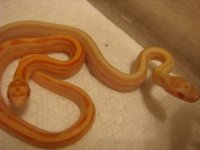cobained
New member
I recently hatched out two creamsicle stripes from cream stripe x hypo lav (surprise hets i guess). first year breeding for both, small clutch, wound up with only 2 good eggs (and 2 more incubating from her surprise second clutch). I was gone the week leading up to their hatch date to be there for my nephew's birth, and my husband didn't do the greatest job keeping up with them. the moss was fairly dry when i got home and both babies had hatched that day. they both clearly have neurological issues (see video) and i'm wondering if you think this could be due to dehydration? eggs were incubated at RT on spaghnum moss, along side a clutch that hatched within a few days with all normal behaving babies.
(could not figure out how to embed the video, so click on the pic to watch it)

(could not figure out how to embed the video, so click on the pic to watch it)


